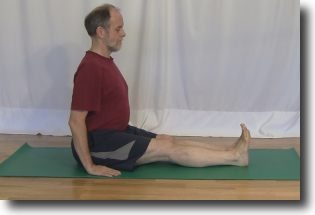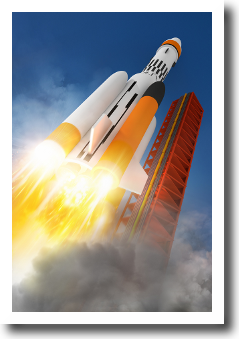3, 2, 1, Ignition!
A single pillar of white hot flame lances down against the launch pad as the Soyuz rocket lifts off with the new crew for the International Space Station.
But what does a rocket launch have to do with Dandasana?
Your torso may look like a rocket when you are in Dandasana, but there is in fact no lift off while you are in the pose. Your hips stay firmly grounded on your launch pad.
What is Dandasana
Dandasana is a seated pose that you return to after you have finished working on another pose. This is the resting position while you prepare for your next pose.
Dandasana helps to improve your posture, stretches your hamstrings, strengthens your back muscles and stretches your shoulder muscles.
Dandasana, pronounced dahn-DAH-sah-nah, is know as Staff pose in English. The pose looks like two staffs. One laying on the ground and the other rising straight up out of the ground. It also looks like a Soyuz rocket waiting to launch into space. But this rocket is not going anywhere.
Before we find out why there is no rocket factor in this pose, let’s have a look at how to do the pose.

Your torso is the rocket, your arms are the scaffolding and your mat is the launchpad for your rocket.
How to do Dandasana
To begin you sit on your mat with your legs together and straight out in front of you. This sets up the launch pad for your rocket.
Now you move the top of your hips above your sitz bones and straighten your back as you lift your torso up. The rocket is in place on top of your launch pad.
Next let your arms descend straight down from your shoulders and your hands rest on the floor beside your hips. The scaffolding that holds the rocket in place is now established.
For a successful launch into space your rocket needs to be pointing straight up into the sky. To have a successful Dandasana your torso needs to rise straight up as well. You accomplish this by drawing your shoulder blades back towards your spine and down towards your hips as you lift your chin and gaze to the horizon.
Hold here for several breaths before you move on to your next pose.
Now that you have your rocket setup on the launch pad it is time to examine the rocket factor and why it is something to be avoided.
What is the rocket factor
The rocket factor happens when you press both your hands into your mat and lift your hips up off of the mat.
In order to lift off you push down into your hands and move your torso up between your shoulder blades, just like the Soyuz rocket rising up from the launch pad.
While this may be easy and fun to do it is not part of the pose.
What is wrong with the rocket factor
Lifting your hips off of your mat creates tension in your shoulders, neck and upper back. This is the opposite effect than what we are attempting to do.
In this pose we are working on removing tension from our upper back and shoulders. Drawing our shoulders back and lowering them down towards the mat allows these muscles to stretch and relax. This movement also helps to improve your posture.
Eliminate the rocket factor and avoid adding tension to your neck and upper back.
How to eliminate the rocket factor
To avoid the rocket factor, rest your hands lightly on the floor beside your hips. Allow your shoulders to descend and lift your ribs up slightly.
Avoid the temptation to press firmly into your hands and lift your hips.
But my arms are longer and my hands easily press into my mat
You may have longer arms than most when compared to your torso or perhaps your shoulders are already down your back and away from your ears.
Whatever the reason, now is not the time to engage the rocket factor.
So, what do you do with your arms if you can not engage the rocket factor. You bend your elbows backwards as you bring your hands to the floor beside your hips. This way you can have your torso tall like the rocket and you also have your shoulders directly over your hands like the scaffolding holding the rocket up. And like the rocket you are sitting firmly on your launch pad and you are not attempting to lift off until the time is right.
Summary
The Soyuz rocket clears the scaffolding and begins its two day journey to the International Space Station. For days before the launch the rocket sat on the launch pad and did not attempt to lift off.
When you are in Dandasana, you are sitting on your launch pad and are not trying to lift off either. There are other poses where you will be lifting off when the time is right.
Now is not the time to engage the rocket factor.
Next Step
Ask your yoga teacher to check out your rocket and scaffolding in this pose. They will be able to help you to get the maximum benefit from Dandasana.
Additional Reading
— Getting the scaffolding in the right place is important for a rocket launch as it is in Dandasana. Read How to build your goal posts in Dandasana to learn more.




